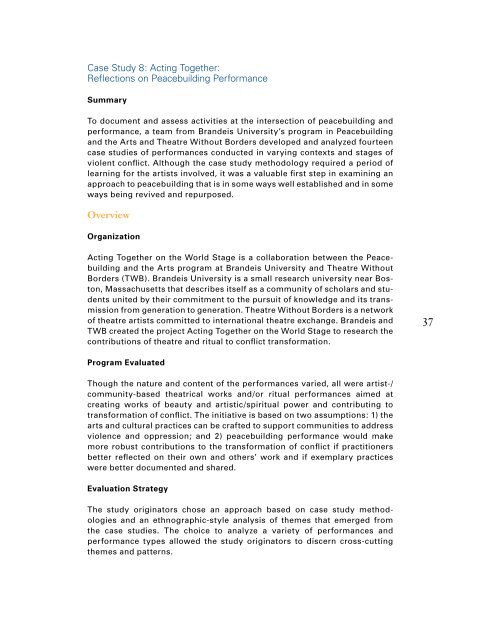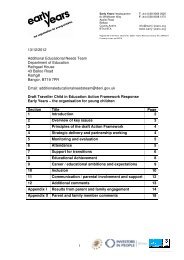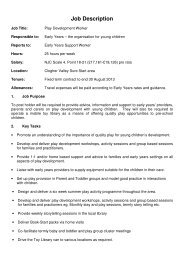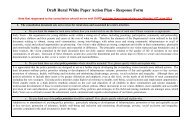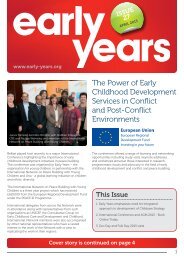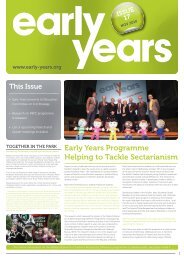Learning from Nine Examples of Peacebuilding Evaluation
Learning from Nine Examples of Peacebuilding Evaluation
Learning from Nine Examples of Peacebuilding Evaluation
Create successful ePaper yourself
Turn your PDF publications into a flip-book with our unique Google optimized e-Paper software.
Case Study 8: Acting Together:<br />
Reflections on <strong>Peacebuilding</strong> Performance<br />
Summary<br />
To document and assess activities at the intersection <strong>of</strong> peacebuilding and<br />
performance, a team <strong>from</strong> Brandeis University’s program in <strong>Peacebuilding</strong><br />
and the Arts and Theatre Without Borders developed and analyzed fourteen<br />
case studies <strong>of</strong> performances conducted in varying contexts and stages <strong>of</strong><br />
violent conflict. Although the case study methodology required a period <strong>of</strong><br />
learning for the artists involved, it was a valuable first step in examining an<br />
approach to peacebuilding that is in some ways well established and in some<br />
ways being revived and repurposed.<br />
Overview<br />
Organization<br />
Acting Together on the World Stage is a collaboration between the <strong>Peacebuilding</strong><br />
and the Arts program at Brandeis University and Theatre Without<br />
Borders (TWB). Brandeis University is a small research university near Boston,<br />
Massachusetts that describes itself as a community <strong>of</strong> scholars and students<br />
united by their commitment to the pursuit <strong>of</strong> knowledge and its transmission<br />
<strong>from</strong> generation to generation. Theatre Without Borders is a network<br />
<strong>of</strong> theatre artists committed to international theatre exchange. Brandeis and<br />
TWB created the project Acting Together on the World Stage to research the<br />
contributions <strong>of</strong> theatre and ritual to conflict transformation.<br />
37<br />
Program Evaluated<br />
Though the nature and content <strong>of</strong> the performances varied, all were artist-/<br />
community-based theatrical works and/or ritual performances aimed at<br />
creating works <strong>of</strong> beauty and artistic/spiritual power and contributing to<br />
transformation <strong>of</strong> conflict. The initiative is based on two assumptions: 1) the<br />
arts and cultural practices can be crafted to support communities to address<br />
violence and oppression; and 2) peacebuilding performance would make<br />
more robust contributions to the transformation <strong>of</strong> conflict if practitioners<br />
better reflected on their own and others’ work and if exemplary practices<br />
were better documented and shared.<br />
<strong>Evaluation</strong> Strategy<br />
The study originators chose an approach based on case study methodologies<br />
and an ethnographic-style analysis <strong>of</strong> themes that emerged <strong>from</strong><br />
the case studies. The choice to analyze a variety <strong>of</strong> performances and<br />
performance types allowed the study originators to discern cross-cutting<br />
themes and patterns.


